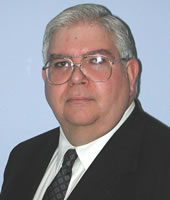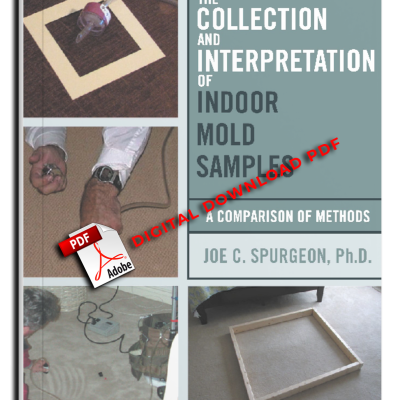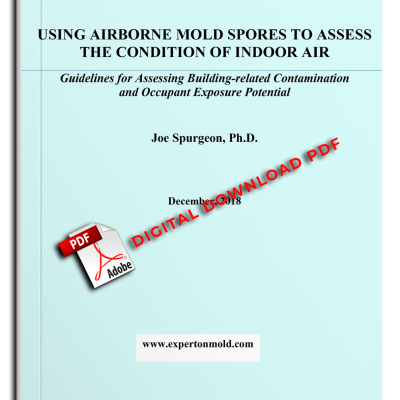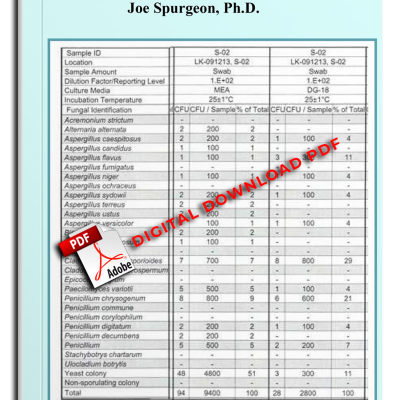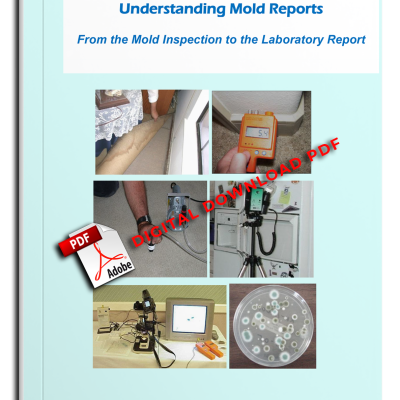Notes on Writing a Mold Report Joe Spurgeon, Ph.D. CIH (1993-2013) July 2024
IF YOU FEEL IT WOULD BE BENEFICIAL TO EXPAND THIS DOCUMENT INTO A BOOK OR MANUAL, PLEASE DROP ME AN E-MAIL WITH YOUR COMMENTS OR SUGGESTIONS
JOSPUR46@GMAIL.COM
PREFACE
This article contains suggestions and guidelines on writing a report following a residential inspection for mold, wildfire smoke residues, VOC’s, or other environmental contaminants. It is intended to describe general concepts and approaches to report writing that can be applied to Contaminants of Concern. The article may be most useful to those inspectors with less experience that primarily perform residential inspections. For simplicity, the book will focus on mold inspections and mold reports.
There are various reasons for writing a mold report, such as for real estate escrows, assessing water intrusions, assessing occupant exposures, post-remediation evaluations or verifications, and for providing expert opinions. Each type of report may require a different format, but the same principles of report writing apply to any inspection or report. First, if the information upon which it was based was not credible then the report will not be credible. If the inspection protocol, sample collection, and/or data interpretation was haphazard, then the resulting conclusions and recommendations will lack support. Second, if it wasn’t documented then it didn’t happen. The time it takes to document and record the findings of an inspection is well spent. But the same principle applies to the report. Document opinions, conclusions and recommendations with facts obtained during the inspection, and appropriate references if necessary. Third, facts trump opinions. Fill the report with as many facts as possible while minimizing unsupported opinions. Link those opinions and conclusions to results and findings. Fourth, the report is the only part of the inspection the client and the professional community can evaluate and judge. The quality and professionalism of the inspection can and will be judged based on the quality of the report. The inspection protocol could have been of the highest quality or substantially deficient. Most clients will not be able to evaluate what was done during a mold inspection, but they will be less than pleased if they cannot understand the report.
INTRODUCTION
PURPOSE
The purpose of the client report is to help someone who doesn’t comprehend mold to understand their options. The purpose of this book is to provide concepts and examples for accomplishing this goal by:
- Documenting the inspection process and results,
- Converting data into usable, actionable information,
- Informing the client about the significance of the findings,
- Effectively communicating that information in a clearly formatted written report.
What makes a quality report? If the inspector can write a report with the following four characteristics it should be of relatively high quality.
- The report should contain reliable, documented data and results.
- The report should contain sufficient facts or data to reach reliable and relevant conclusions and recommendations with a minimum of unsupported opinions.
- The report contents should be the product of reliable, generally accepted principles and methods appropriate for the project objectives and conditions.
- The inspector should have reliably applied those principles and methods to the facts, objectives, and conditions of the project.
COMMON PROBLEMS
This article was prompted by my experience as an expert witness, which has allowed me to review hundreds of reports written by many different mold inspectors. Those reports provided an overview of a reasonably broad cross section of the Indoor Air Quality (IAQ) industry. When reviewing these reports, a set of similar problem areas tended to commonly occur in residential mold reports. The result was a recognition that at least some guidance on report writing, however rudimentary, may be useful to residential mold inspectors. The following problem areas summarize the hundreds of residential inspection reports that were reviewed.
No statement of objective/s. Without a stated objective it’s difficult to write a report with a rational assessment of the results. It’s not only a matter of clearly stating the objective, but it’s often apparent the inspector didn’t take the time to understand the objective of the inspection. Stating the objective provides the reader, the remediation contractor, and interested third parties with that knowledge. But more importantly formulating and knowing the specifics of the project objects prior to the inspection forces the inspector to think about which protocols and methods will be required to accomplish those objectives. For example, it was not unusual for the inspector to select a sampler or method or analysis that was not capable of detecting a Contaminant of Concern. This would not have happened if the inspector had understood the project objectives.
No Sampling Plan or Sampling Rationale. Most mold reports were based on one or possibly two sampling methods; and it was obvious they were selected prior to the inspection. These were frequently total airborne spores and possibly surface tape lifts. Nothing wrong with using those methods if they are consistent with the project objectives and the incident history. However, this was often not the case. In addition, if three airborne samples were collected, two were frequently outdoor samples and only one was an indoor sample. The sampling rationale describes how the sample will support a project objective.
- Why am I collecting this sample, in this location, with this sampler?
- What do I expect to learn from the sample result?
- What will it mean if the result is low, if the result is elevated?
- How does the sample have to be analyzed to support the objective?
- Which interpretation method do I need to use to support the objective?
Poor documentation of the inspection. The visual inspection was sometimes included in the report but not a site characterization, occupant interview, incident history, moisture content log, description of sampling methods, or field sheets documenting sample collection and sampling locations. Taking a photo of a moisture meter reading does not really qualify as “documenting” moisture content. Collecting total airborne mold spores and not reporting which sampler was used, calibration, sample times, etc. might also be considered a deficiency in the report.
The inspection was not sufficiently complete to determine the significance of the mold spores. The inspector did not demonstrate the expertise required to assess the sample results. Almost all residential mold reports were data reports rather than assessment reports. These documents reported the sample results and findings without assessing the significance of the results. Whenever sample results were interpreted, the decision criteria selected for assessing the significance of the sample results were often not understood and misapplied.
Opinions, conclusions and recommendations were not supported by referencing them to results and findings. They were not supported by associating them with, and linking them to, specific sample results, measurements, and findings in the report.
The sample results were “interpreted” by the laboratory. A substantial number of residential mold reports were essentially just laboratory reports with a cover page attached.
The report cited organizational references (IICRC, AIHA, etc.) that were misinterpreted and contradicted by the methodologies described in the report. Citing these references detracted from the credibility of the report and increased the legal liability of the inspector.
An adequate “Methods” section was not included in any of the residential mold reports. A written description of standardized methods and sampling procedures that were reproducible between projects and between technicians in larger organizations.
ISSUES WITH SAMPLE COLLECTION
Having a Sampling Plan provides a foundation for writing a quality report. We have all probably heard the adage “garbage in, garbage out”, and it certainly applies to sample collection, sample analysis, and data interpretation.
In order to have a solid basis for a quality report, the development of the sampling protocol should have included the following four factors.
1. The samples should be collected in accordance with an accepted methodology or standard.
Unfortunately, there are very few standardized sampling methods in Indoor Air Quality (IAQ). For example, there are no standardized methodologies for the collection and analysis of airborne, hard surface, soft surface, carpet, HVAC, or wall cavity samples. Even if they appear to be the same, the sample preparation steps can vary between laboratories.
2. The sample results should be representative or indicative of damage to the home.
This is affected by at least two elements. First, the sampling plan. Were the samples collected using a sampler that could detect the Contaminant of Concern, where it could be detected, and was the sample analyzed appropriately? Second, were the collected samples representative of the indoor environment or were they biased to show a desired result?
3. The samples should be handled in accordance with an accepted methodology or standard.
Were the samples properly labeled, the sample locations documented in a field sheet, and a chain of custody properly executed.
4. The sampling methodology should be a written document.
Does the inspection company have a written field manual describing procedures and methods? Were the relevant procedures and methods described in the report? The Company should develop standardized sampling procedures that are described in the field manual.
WRITING AN ASSESSMENT REPORT
To “assess” means to “determine the significance of” or “the meaning of”. If the objective is to write a quality report, then a quality report is an ASSESSMENT report, not a DATA report. It’s not enough to simply report the results of the inspection. The client and the remediation contractor want to know the significance of the results. This means the inspector needs to use the report to convert “data” into usable, actionable “information”. One approach to converting data into information is by:
- Knowing the objectives. Is it to assess:
-
- Escrow, assessment, PRV, etc.
- Building-Related Contamination (probably most inspections),
- Occupant Exposure Potential (maybe 25% of inspections),
- Clean or discard contents.
- Using sampling methods and procedures appropriate to project objectives. Is the objective to detect:
- Total mold spores or fungal species,
- Visible mold and hidden mold,
- Mycotoxins and endotoxins,
- Allergens.
- Applying those methods reliably and in a consistent, repeatable manner. Are project methods and procedures in a written format and have project personnel been adequately trained?
In order to have the greatest utility, a sampling method should have as many of the following characteristics as possible, referred to as the “SOCS” criteria.
- Significance. The significance of the sample result is provided. Is the sample result high, low, or average?
- Objective. The numerical guidelines and decision criteria for assessing condition is independent of variations in personnel training, experience, or personal bias.
- Consistent. The criteria for assessing the condition of the indoor environment can be applied consistently across projects and between inspectors.
- Stable. The basis for assessing condition is stable; and is independent of local ambient conditions.
- Interpreting sample results using an appropriate method. There are three basic methods for interpreting airborne samples, for example:
- Reference Method, comparing indoor to outdoor samples,
- Control Method, comparing potentially contaminated areas to control areas,
- Database Method, comparing current samples to similar previously collected samples.
- Knowing the approximate decision criteria that will be used to assess the sample results. The primary goal of an IAQ inspection is to differentiate between normal and contaminated indoor environments.
- Sample results or measurements that will classify the indoor space as acceptable or unacceptable.
- Explaining what was found in nontechnical language that the client can understand.
- Explain the meaning and implications of the results and findings.
- Explain the client’s options.
- Supporting recommendations by linking them to specific conclusions and linking conclusions to identifiable results and findings.
- Associating conclusions with specific results and data tables.
DATA TABLES
Preparing Data Tables is a critical step in writing a quality mold report. This is a personal preference, but I never assess sample results of any kind directly from a laboratory report. I always transfer the reported results into a data table first using rank order analysis, look for patterns and concentration gradients, then assess the results. Rank order analysis is simply arranging the Contaminant of Concern from highest to lowest concentration or lowest to highest concentration. For example, for airborne mold samples collected using a slit-impaction cassette, Aspergillus/Penicillium (Asp/Pen) spores will probably be the Contaminant of Concern.
Presenting the results for the dominant contaminant spores in a Data Table allows the inspector to:
- Present clearer results by only including the dominant contaminant mold spores,
- Arrange the dominant contaminant spore type in Rank Order for indoor and outdoor samples,
- Calculate additional parameters such as Percentage of total spores,
- Detect trends in the data such as IICRC Conditional Areas and Control Areas,
- Allows conclusions to be associated with specific data tables.
When interpreting Data Tables like those in Table 1 follow these steps.
- Review the laboratory report [air, surface, etc.],
- Identify the dominant contaminant spore types to include in the Data Table,
- Construct rank-order data tables for each sample type [air, surface, wall cavity, etc.],
- Look for trends and gradients in the data [concentration, percentage],
- State the conclusions associated with each data table,
- Provide actionable recommendations supported by those conclusions.
Table 1. Example Data Table for Airborne Mold Spores (Spores/m3).
| Floor | Location | Asp/Pen | Asp/Pen (%) | Stachy | Total Spores |
| 2 | Mstr Bdrm | 4,347 | 99 % | 4,360 | |
| 2 | Mstr Bth | 3,573 | 94 % | 13 | 3,800 |
| 3 | Office | 840 | 91 % | 920 | |
| 2 | Family Rm | 520 | 61 % | 840 | |
| 1 | Foyer | 280 | 58 % | 27 | 480 |
| 0 | Outside | 180 | 4.3 % | 4,140 | |
| 1 | Rec Rm | 147 | 78 % | 187 | |
| 1 | Bedroom | 53 | 49 % | 107 |
- Look for patterns in Asp/Pen concentrations.
- Look for patterns in Asp/Pen (%).
- Look at locations where Stachy was found.
Just based on sample results (incident history and inspection results not available).
Which areas were IICRC Condition 3?
Which areas were IICRC Condition 2?
Was there a Control Area (IICRC Condition 1)? [Hint: Outdoor air was 4.3% Asp/Pen]

